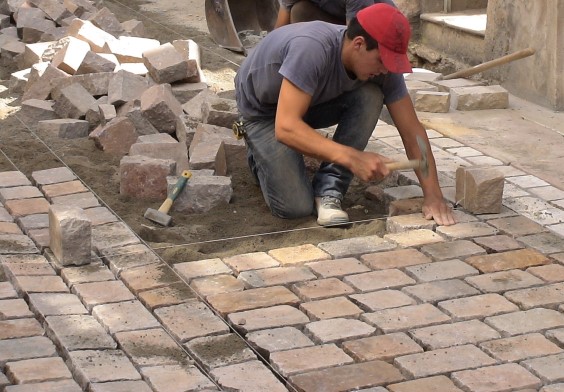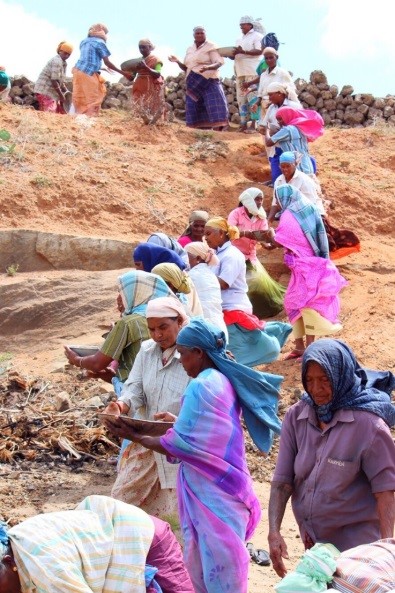Better Rural Transport Calls for Local Solutions to Local Challenges
This blog post was originally released by the Research for Community Access Partnership (ReCAP) in here.
Much of the research that ReCAP commissions looks into the appropriate use of locally available solutions and resources, specifically addressing the local issues and environments, for improving rural access and mobility. We are pleased to share with you a blog post on this theme by Ms Pratidnya Bhuite, postgraduate research student, Rural Roads Research Group, University of Birmingham.
The Roads Research Group in Civil Engineering at the University of Birmingham, United Kingdom, has over the last 50 years built a world-leading centre of excellence in research, education and capacity building in and with low-income countries, including Sub-Saharan Africa (SSA) and South East Asia. The Group’s research and capacity building in Rural Roads focus is on the provision of safe, reliable, economic and climate-resilient rural access to support the growth of developing economies. Asset management and geotechnical engineering are its two principal research areas. Evidence of the Group’s track record and excellence was recently recognised by The UK Collaborative on Development Sciences (UKCDS). The group currently partners with the Partnership for Sustainable Low Carbon Transport to enrich rural transport advocacy inputs with research evidence.
 Ms Pratidnya Bhuite, our blogger, graduated from the University of Birmingham, where she earned MSc Construction Management degree. Her dissertation, entitled “Critical evaluation on Indian Green buildings: A SPeAR Analysis” is a study to critically analyse and compare the sustainability performance of buildings in India to those in developed countries like US, UK, Japan and Australia. She used an independent assessment system, the Sustainable Project Appraisal Routine (SPeAR®), developed by ARUP. Her academic interests include construction management and implication of sustainability in the construction industry. She hopes to pursue a PhD in sustainable building design/construction.
Ms Pratidnya Bhuite, our blogger, graduated from the University of Birmingham, where she earned MSc Construction Management degree. Her dissertation, entitled “Critical evaluation on Indian Green buildings: A SPeAR Analysis” is a study to critically analyse and compare the sustainability performance of buildings in India to those in developed countries like US, UK, Japan and Australia. She used an independent assessment system, the Sustainable Project Appraisal Routine (SPeAR®), developed by ARUP. Her academic interests include construction management and implication of sustainability in the construction industry. She hopes to pursue a PhD in sustainable building design/construction.
Better rural transport calls for local solutions to local challenges
Pratidnya Bhuite, PhD Researcher, School of Civil Engineering, University of Birmingham
Rural roads provide the minimum infrastructure to sustain and improve the socio-economic development of rural areas and make an important contribution to the development of rural communities (Lebo & Schelling, 2003). Many developing and emerging economies face major constraints on rural access, such as the lack of all-season access, poor road conditions and connectivity, and the poor availability, reliability and affordability of transport services. Financial and technical constraints are often severe, which makes improving rural infrastructure and transport services challenging. A local-resource based approach, making use of local materials, labour, skills and technologies, is a potential solution to, at least partially, overcome such challenges.

Figure 1. Construction of a dressed stone low volume rural road using locally sourced materials
Local materials and equipment
The use of locally available materials for construction and maintenance of rural roads can help reduce the cost of construction, contribute to the development of the local economy and improve the sustainability of road projects. For example, in Okhaldhunga District, Nepal a so-called green road approach has been adopted whereby locally available materials and labourers have been used to construct rural roads under the District Road Support Programme (DRSP) The approach resulted in a 50% reduction in capital costs associated with road construction and it is estimated that over 65% of the value of the cost of the project has remained within the local economy (Mulmi, 2009). Road pavement trials in Cambodia, Laos and Vietnam have demonstrated the sustainable benefits of using locally sourced materials to construct block road surfaces (Figure 1) to appropriate design standards for environments subject to high precipitation (Burrow et al., 2016). Similarly, in Asosa, Ethiopia, the construction costs of road base courses for low volume sealed roads have been reduced by between 45% and 60% by using local materials (Otto, Endale, & Greening, 2015). In Rajasthan, India, the use of calcareous material, known as Dhandla, has reduced construction cost for roads in desert areas to 28% of the cost of using traditional approaches (Bhasin et al., 2017).
The benefits of recycling available materials, coupled with a sound design approach, have been demonstrated in rural communities in Myanmar, the Philippines and Kenya, whereby spot improvements to rural roads have been effected by using surplus woven bags (used previously to transport crops and fertilizers) to act as geotextiles. The bags have been filled with locally available gravels to provide a strong base course. This approach, combined with the use of locally available labour, has reduced the costs of road maintenance to only $5 to $12/m (Fukubayashi & Kimura, 2014).
The use of appropriate maintenance technology is also an important consideration. For example, research in Kenya, Tanzania, Zimbabwe and Zambia has shown that for earth and gravel road maintenance the use of graders towed by farm tractors is effective and far more cost efficient than motor graders (Gongera and Petts, 2016). Not only does this approach have significantly less capital and recurrent maintenance costs, but the tractor can be used to support farming activities for most of the year.

Figure 2. Tractor towed grader technology demonstrated near Bulawayo, Zambia
Local labour and skills
A report by the International Labour Organisation (ILO) has demonstrated that it is feasible to involve the local population more extensively in the construction and maintenance of rural roads and thereby providing long term employment opportunities and additional market prospects for the local construction industry (Bjorn Johannassen Engineering Consultant, 1997). Not only do such programmes have the potential for direct employment in construction, but secondary employment opportunities can also arise, for example jobs to do with driving vehicles and working in automobile workshops (Mulmi, 2009).Examples of this include the DRSP programme in Nepal alluded to earlier, which generated 4.2 million person days of employment for unskilled and skilled local people. Community-based maintenance of 656 km of rural roads in Dehong, China, has resulted in 80% of the local population having all-season access and the direct employment of over 1,600 locals and 350 migrants (ADB, 2011). In Bihar-India, a $235 million rural road building and rehabilitation programme provides all-season roads to almost 1.2 million people and direct employment to 20 million local labourers (The World Bank, 2017) Labour-based initiatives can promote gender equality, for example, in the traditionally male-dominated labour market in southwest of Bangladesh, 75% of those engaged in road maintenance are women (Schmid, Bartholdi, Moosmann, Czeh, & Engelskirchen, 2013).

Figure 3. Women involved in rural road maintenance, Tamil Nadu, India
Transport services
Along with better road infrastructure, affordable transport services tailored to local needs are often an overlooked but vital component of the sustainable provision of rural access. The Government of India’s rural transport programme (“Pradhan Mantri Gram Parivahan Yojana”), provides connectivity and employment opportunities in remote villages. Through the programme, the Indian Ministry of Rural Development is providing substantial grants to rural entrepreneurs to buy vehicles; the operators are selected through local self-help groups including women, dalits and tribals belonging to families being below the poverty line (Dash, 2016).
In Tanzania, rural areas often suffer from a lack of affordable transport services due to the high operating and maintenance costs of conventional vehicles; these were found to be significantly higher than in Asia (Hine et al., 2015). Consequently, lower speed alternative modes, such as motorcycle trailers and three-wheelers, are becoming popular since they are driven and owned by locals. For example, there are estimated to be over 10,000 registered local riders in rural areas of Tanzania playing a vital role in allowing people to access services such as healthcare and education (Transaid, 2017). The operating costs of these modes are almost half that of conventional vehicles (Dennis & Pullen, 2017)The services provided range from carrying passengers, ferrying goods to and from market (as in Kamuli, Uganda; Tonkolili, Sierra Leone and Chongwe, Zambia) (Geddes et al., 2017) and taking women to maternity clinics (Transaid, 2015). It should be noted however, that there are concerns over the safe use of motorcycles and three wheelers as taxi services (Transaid, 2017).

Figure 4. Motorcycle use in Sierra Leone, Africa
Conclusion
Affordable, reliable and safe rural access in developing economies is crucial in helping to meet the socio-economic needs of rural communities. However, rural access is severely constrained in many areas due to inappropriate design, inadequate maintenance which causes road networks to deteriorate more rapidly than expected, and a lack of affordable transport services. This has a negative impact on local communities as it increases transport costs, reduces accessibility to essential services and limits social interaction. The local solutions can help to address these issues since they can be sustainable and cost effective. Such solutions include appropriate road design standards tailored to local needs; the use of locally sourced materials for road construction and maintenance, the use of alternative maintenance technologies; and the engagement of local communities in providing labour, skilled work and transport services. By so doing, socio-economic benefits accrue to the wider community, and help to ensure the preservation of the road networks. Consequently, the use of local solutions for rural transport may be seen as an important enabler to achieving the Sustainable Development Goals associated with No Poverty, Zero Hunger, Good Health and Well-being, Quality Education, Clean Water and Sanitation and Sustainable Cities and Communities.
————-
This blog post was originally released by the Research for Community Access Partnership (ReCAP) in here.
This article is part of a set of Key Messages on Rural Transport and Sustainable Development Goals developed in the framework of the UKAid funded Research for Community Access Partnership (ReCAP), facilitated by the Partnership on Sustainable, Low Carbon Transport (SLoCaT). More details on the key messages can be found in the associated factsheet and supporting paper.
References
IT Transport (2013). Improved maintenance systems for district roads in Tanzania, Final Report. Africa Community Access Programme (AFCAP). Sutton: Crowne Agents.
Bhasin, N., Oli, P., Krishan, N., & Chander, J. (2017). Use of Low Grade Materials for Rural Road Construction in Desert Areas. Available at: http://pmgsy.nic.in/pmg9104.asp [Accessed on: 04-09-2017]
Bjorn Johannassen Engineering Consultant. (1997). Labour-based Road Construction and Maintenance Technology. Available at: http://www.ilo.org/wcmsp5/groups/public/—ed_emp/—emp_policy/—invest/documents/instructionalmaterial/wcms_434504.pdf. [Accessed on: 04-09-2017]
Burrow, M.P.N., Evdorides, H., Ghataora, G.S., Petts, R., Snaith, M.S. (2016). The evidence for rural road technology in low income countries. Transport Proceedings Institution of Civil Engineers. 169(6) pp. 366-377. Available at: http://dx.doi.org/10.1680/jtran.15.00089.
Dash, D. ( 2016, June 2). Ministers Come Together to Boost Rural Transport. In: Times Of India. Available at: https://timesofindia.indiatimes.com/india/Ministries-come-together-to-boost-rural-transport/articleshow/52560759.cms. [Accessed on: 31-08-2017]
Dennis , R., & Pullen, R. K. (2017). Vehicles for rural transport services in Sub-saharan Africa. Proceedings of the Institution of Civil Engineers. Transport. 170(6) pp. 321-327. Available at: 10.1680/jtran.15.00081
Donnges, C. (2003). Improving Access in Rural Areas-Guidelines for Integrated Rural Accessibility Planning. Geneva: International Labour Organization. Available at: http://www.ilo.org/wcmsp5/groups/public/—asia/—ro-bangkok/documents/publication/wcms_bk_pb_216_en.pdf. [Accessed on: 05-08-2017]
Fukubayashi , Y., & Kimura, M. (2017). Spot Improvement of Rural Roads Using a Local Resource‐ Based Approach: Case Studies from Asia and Africa, International Development, S. Appiah-Opoku (Ed.), InTech, DOI: 10.5772/66109. Available from: https://www.intechopen.com/books/international-development/spot-improvement-of-rural-roads-using-a-local-resource-based-approach-case-studies-from-asia-and-afr [Accessed on: 20-08-2017]
Geddes, R., Lema, C., Bopoto, C., Gongera, K., Pinard, M. (2017). Economic Growth through Effective Road Asset Management (GEM), Consolidated Baseline Study Report. London: ReCAP for DFID.
Gongera K. and Petts R. C. (2016). Scoping study for the Establishment of a Pilot Project to implement tractor-based road maintenance approaches in Zambia, Final Assignment Report. Africa Community Access Partnership (AfCAP). London: ReCAP for DFID.
Hine J, Abedin M, Stevens RJ, Airey T, Anderson T (2015). Does the extension of the rural road network have a positive impact on poverty reduction and resilience for the rural areas served? If so how, and if not why not? A systematic review. London: EPPI-Centre, Social Science Research Unit, UCL Institute of Education, University College London.
Lebo , J., & Schelling, D. (2003). Low Volume Rural Roads. World Bank Technical Paper No. 496. Available at: https://www.its.leeds.ac.uk/projects/WBToolkit/Note16.htm#_edn1. [Accessed on: 24-08-2017]
Mulmi, A. D. (2009). Green Road Approach in Rural Road Construction for the Sustainable Development of Nepal. Journal of sustainable development, Vol 2, No. 3.
Otto, A., Endale, A. A., & Greening, P. K. (2015). Method for Increasing the Use of Locally Available Materials for Road Construction in Ethiopia by Allowing for Climatic Variations. Journal of Transport Research Board, pp 108–115. Washington D.C., USA.
Schmid, D., Bartholdi, M., Moosmann, K., Czeh, A., & Engelskirchen, M. (2013, August). The contribution of Transport to Rural development. In: Improving the accessibility of rural areas. Available at: https://www.giz.de/expertise/downloads/giz2013-en-the-contribution-of-transport-to-rural-development.pdf [Accessed on: 19-08-2017]
The Asian Development Bank (ADB) (2011). People’s Republic of China: Yunnan Integrated Road Network Development Project. Manila: The Asian Development Bank
The World Bank. (2017). India Rural Road Projects. The World Bank-IDA. New Delhi, India: The World Bank-IDA.
Transaid (2015). New boda boda curriculum. Available at: http://www.transaid.org/news/training-curriculum-for-motorcycle-riders-in-tanzania/. [Accessed on: 31-08-2017].
The views expressed in this blog post are of the author only and do not necessarily reflect the views of ReCAP or Cardno Emerging Markets (UK) Ltd, for whom the post was prepared.